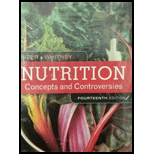
Concept explainers
Concept Introduction:
The lifestyle these days, include more of non-nutritious foods and drinks. From them, coffee and caffeinated drinks are most common. The working hours have increased a lot and people want to stay charged up with energy. Also, the work stress is more. Apart from this, people face a lot of emotional turmoil. So they tend to enjoy junk food more, as it tastes good and makes them feel good.
Answer to Problem 1RQ
Correct answer:
The correct answer is option (a), ‘19 percent of young woman’s daily calorie intake’.
Explanation of Solution
From the survey conducted, females take about 450 calories from the beverages and this is from the 2400 calorie diet. This accounts for 19 percent of the portion. Therefore, option (a) is correct.
Option (b) is incorrect as it is quite less from what is observed.
Option (c) is incorrect because it’s just ‘19 percent’. This calorie consumption is mainly because of coffee and other beverages consumed.
Due to excessive consumption of beverages, both male and female, get most of the required sugars from drinks only.
Want to see more full solutions like this?
Chapter 8 Solutions
Bundle: Nutrition: Concepts and Controversies, Loose-leaf Version, 14th + LMS Integrated for MindTap Nutrition, 1 term (6 months) Printed Access Card
 Comprehensive Medical Assisting: Administrative a...NursingISBN:9781305964792Author:Wilburta Q. Lindh, Carol D. Tamparo, Barbara M. Dahl, Julie Morris, Cindy CorreaPublisher:Cengage Learning
Comprehensive Medical Assisting: Administrative a...NursingISBN:9781305964792Author:Wilburta Q. Lindh, Carol D. Tamparo, Barbara M. Dahl, Julie Morris, Cindy CorreaPublisher:Cengage Learning Human Biology (MindTap Course List)BiologyISBN:9781305112100Author:Cecie Starr, Beverly McMillanPublisher:Cengage LearningEssentials of Pharmacology for Health ProfessionsNursingISBN:9781305441620Author:WOODROWPublisher:Cengage
Human Biology (MindTap Course List)BiologyISBN:9781305112100Author:Cecie Starr, Beverly McMillanPublisher:Cengage LearningEssentials of Pharmacology for Health ProfessionsNursingISBN:9781305441620Author:WOODROWPublisher:Cengage





